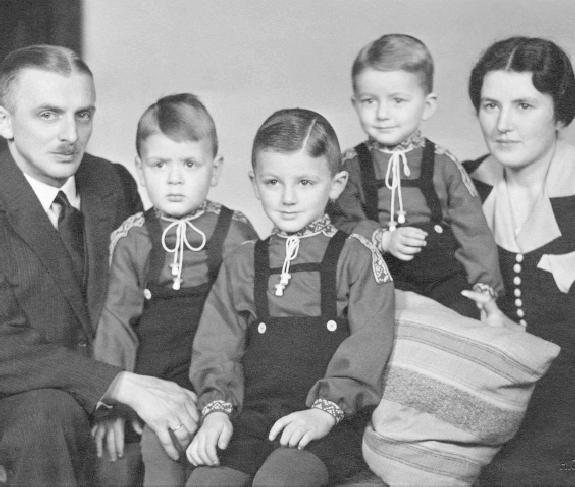
German Boys Clothes: Herbert Heim Middle Class Family

Figure 1.--This German mother in 1939 has outfitted all her sons in identical outfits. They wear blouses with folk detailing and identical suspender shorts with lederhosen halter styling with long stockings. The long stockings appear to be the same color as the blouses. Notice that the hair styling is similar, but that one boy has a left part and the others a right part. It seems a bit strange to go to the lenhth of dressing the children identically and then not combing their hair alike--especially with such careful parts.
|
|
This looks to be a comfortable middle class family which was photographed in 1939. We have little informationa bout the family, but the father looks to be a professional or businessman. His name is Herberrt Heim. (We are attempting to dechipher the writing on the back.) His wife is stylishly dressed and she had carefully outfitted their thress sons in identical outfits, colorful folk blouses and H-bar suspender short pants rather like lederhosen. The shorts are, however, cloth not leather. It is likely that mother made these outfits herself. The boys wear long stockings which to be the same color as the blouses. Notice that the hair styling is similar, but that one boy has a left part and the others a right part. It seems a bit strange to go to the length of dressing the children identically and then not combing their hair alike--especially with such careful parts.
The Family
This looks to be a comfortable middle class family which was photographed in 1939. We have little information about the family, but the father looks to be a professional or businessman. His name is Herberrt Heim.
Note
There is a note on the back of this postcard portrait. It reads, "Gewidmet von Eurem dankbaren Herbert Heine/Heim u. Familie. Weihnachten 1939." That translates as "Dedicated from your grateful Herbert Heine/Heim and Family. Christmas 1939" u. is an abbriviation of und (and). Eurem is "from you" or "yours" ( plural). Single in this case would be Deinem. The hand writing is difficult to read. Our German reader at first thought it said Geibe, but finally decided on Heim.
Heine
A HBC reader tells us, "By the way one of Germany's greatest 19th century poets and writers was Heinrich Heine, who was Jewish. One of his poems "Ich weiss nicht was soll das bedeuten" ("I don't know what this will mean") became a folk song, composed by Felix Mendelssohn (another Jew) and was so popular that that the Nazis could not ignore it. They just proclaimed "Dichter unbekannt" (poet unknown). But of course everybody knew who he was. "
Name
t is possible that this was a Jewish family, although Heine is not an outspoken Jewish name. There even used to be an SS General by that name. Heinrich Heine had Jewish parents who had him baptized as a Protestant Christian. If I misread that name and it is really Heim, then that family still could be Jewish, because Heim or Heym is more Jewish than Heine. A well-known German writer was Stefan Heym--a Jew. On the other hand the
"philosopher" of the Nazi Party was Alfred Rosenberg, who was born in Estonia and studied in Moscow. With that name and background one wonders. HBC concluded that the fact that the family is sending Christmas greetings and looks very prosperous suggests, the mother ;ooks to have just been to a hair dresser, suggests that they are no Jewish. The Jews by 1939 had been economically isolated and most were in serious economic straits. Also I think by 1939, the NAZIs required that Jews use destinctly Jewish (meaning Old Testamaent first names.
Clothing
His wife is stylishly dressed and she had carefully outfitted their three sons in identical outfits, colorful folk blouses and H-bar suspender short pants rather like lederhosen. The shorts are, however, cloth not leather. It is likely that mother made these outfits herself. The boys wear long stockings which look to be the same color as the blouses. A German reader tells us, "Surely the stockings were brown, but most probably the blouses were a different color. I had a similar blouses (but without the string around the neck) about the same time. My garment was blue and in fact were smocks ("Fuhrmannskittel")--I was 6 years old in 1939."
Hair Style
Notice that the hair styling is similar, but that one boy has a left part and the others a right part. It seems a bit strange to go to the length of dressing the children identically and then not combing their hair alike--especially with such careful parts. A German reader ponys out, "Remember that the hair was made according to the pattern how the hair behaved itself. The position of the part was thus chosen according to the given circumstances. This may explain the difference here."
HBC

Navigate the Boys' Historical Clothing Web Site:
[Introduction]
[Activities]
[Biographies]
[Chronology]
[Clothing styles]
[Countries]
[Bibliographies]
[Contributions]
[Essays]
[FAQs]
[Glossaries]
[Satellites]
[Tools]
[Boys' Clothing Home]
Navigate the Boys' Historical Clothing Belgin pages:
[Return to the Main German family page]
[Return to the Main German page]
[German choirs]
[German movies]
[German royals]
[German schools]
[German military schools]
[German youth groups]
[String ties]
[H-bar shorts]
Created: November 13, 2002
Last updated: November 13, 2002



